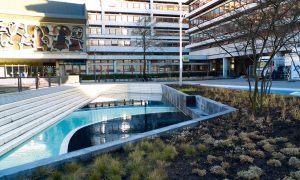Giovanna Dunmall in The Economist:
 One evening in March, a pale-blue layer of light began spreading across the plaza outside the United Nations headquarters in New York. Emanating from banks of leds, it appeared to undulate like the surface of the sea high above the heads of passing pedestrians. The effect may have been ethereal but the warning was all too real: the light submerged the plaza to the same depth that water may do if nothing is done to control rising sea levels. Called “Waterlicht” (Waterlight), the installation was the work of Daan Roosegaarde, a Dutch artist; New York was just one stop on a tour of global cities. Roosegaarde’s intention is to focus people’s minds on the prospect of a watery future. “Above all it gets people who might never do so talking about water and global warming,” he says. Often the conversation turns to keeping water out. But increasingly urban planners and designers are taking their cues from Rotterdam, the city where Roosegaarde lives and works: they are working out how to let water in. Like thousands of coastal cities from Shanghai to Miami, Osaka to New York, Rotterdam is under threat. More than 80% of this port on the Netherlands’ North Sea coast lies below sea level, the ocean kept at bay by a sophisticated system of levees, dykes, dams and storm-surge barriers known as the Delta Works. But by the end of the century those sea levels are predicted to rise by around a metre and the Netherlands is already seeing an increase in rainfall and flooding. To make matters worse, the thousands of pumps that remove groundwater up and down the country are causing the peat to dehydrate and the ground to sink. In recent years this has led to a shift in thinking: instead of working against the water, why not re-engineer the city to work with it?
One evening in March, a pale-blue layer of light began spreading across the plaza outside the United Nations headquarters in New York. Emanating from banks of leds, it appeared to undulate like the surface of the sea high above the heads of passing pedestrians. The effect may have been ethereal but the warning was all too real: the light submerged the plaza to the same depth that water may do if nothing is done to control rising sea levels. Called “Waterlicht” (Waterlight), the installation was the work of Daan Roosegaarde, a Dutch artist; New York was just one stop on a tour of global cities. Roosegaarde’s intention is to focus people’s minds on the prospect of a watery future. “Above all it gets people who might never do so talking about water and global warming,” he says. Often the conversation turns to keeping water out. But increasingly urban planners and designers are taking their cues from Rotterdam, the city where Roosegaarde lives and works: they are working out how to let water in. Like thousands of coastal cities from Shanghai to Miami, Osaka to New York, Rotterdam is under threat. More than 80% of this port on the Netherlands’ North Sea coast lies below sea level, the ocean kept at bay by a sophisticated system of levees, dykes, dams and storm-surge barriers known as the Delta Works. But by the end of the century those sea levels are predicted to rise by around a metre and the Netherlands is already seeing an increase in rainfall and flooding. To make matters worse, the thousands of pumps that remove groundwater up and down the country are causing the peat to dehydrate and the ground to sink. In recent years this has led to a shift in thinking: instead of working against the water, why not re-engineer the city to work with it?
At first glance, Rotterdam’s Benthemplein (below) looks like a pleasant but ordinary city square. It has a basketball court, skateboarding ramps and benches. Look a little closer, however, and you begin to notice an array of wide, stainless-steel gutters zig-zagging around it; striking green, white and blue water-themed patterns on the ground; and two shallow basins that appear to feed into the basketball court, which is surrounded by stepped seating. Benthemplein is actually one of five water plazas in Rotterdam and was designed by De Urbanisten, an architecture firm based in the city. A receptacle for up to 1.7m litres of excess water, it funnels the flow from surrounding streets and rooftops. When heavy rain comes the two smaller basins fill up before feeding a third, deeper one, their contents gushing over a beautiful “water wall”. In dry weather the square, which is also planted with tall grasses and shrubs, is a buzzing hub. In wet weather it becomes an inner-city lake.
More here.
